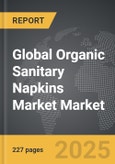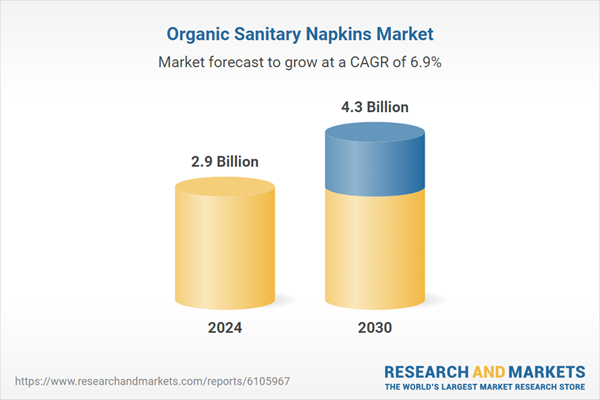Global Organic Sanitary Napkins Market - Key Trends & Drivers Summarized
Why Are Organic Sanitary Napkins Becoming a Preferred Choice for Menstrual Hygiene?
Organic sanitary napkins are gaining traction as more women seek menstrual products that are safer for the body and less harmful to the environment. These napkins are made using organic cotton and plant-based absorbents, free from synthetic chemicals, chlorine, artificial fragrances, and plastic-derived components. Growing awareness of skin sensitivities, allergic reactions, and long-term health risks associated with conventional products is influencing a shift in consumer preferences toward organic variants.In addition to personal safety, concern for environmental impact is also driving demand. Conventional sanitary napkins take years to degrade due to plastic content. Organic napkins, by contrast, are often biodegradable and compostable. These features align with increasing demand for low-waste and eco-friendly personal care items. The transition is particularly strong among urban consumers with higher awareness of product content, menstrual health, and sustainability.
How Are Product Design, Materials, and Distribution Channels Supporting Market Expansion?
Manufacturers of organic sanitary napkins are focusing on comfort, breathability, and effective absorption while maintaining environmental standards. Modern products feature organic cotton topsheets, biodegradable back films, and adhesives derived from natural starches. Innovations such as winged designs, ultra-thin formats, and individually wrapped pads are being tailored to meet both hygiene and convenience needs without compromising organic integrity.Certifications from organizations like USDA Organic, ICEA, or GOTS are used to validate raw materials and manufacturing practices. Packaging is being improved through recyclable or compostable materials that appeal to sustainability-focused buyers. Distribution through online platforms, direct-to-consumer subscriptions, and retail pharmacies is expanding product availability. Partnerships with health NGOs and menstrual awareness campaigns in schools are also playing a role in promoting adoption.
Where Is Market Adoption Rising and Who Are the Key Consumer Groups?
Demand for organic sanitary napkins is strongest in North America and Europe, where consumers actively seek ingredient transparency and sustainable products. Adoption is also growing in urban areas across Asia-Pacific and Latin America, aided by rising income levels, education, and government support for menstrual hygiene initiatives. Consumers with sensitive skin, allergies, or interest in clean-label personal care are key adopters.Women in the age group of 18 to 35 form the core market segment. Brand choices are influenced by access to product details, peer reviews, and ethical positioning. Subscription services offering customizable menstrual care boxes are gaining popularity among younger consumers. Health professionals and wellness influencers are helping build awareness around organic options and their dermatological benefits.
Growth in the Organic Sanitary Napkins market is driven by several factors…
Growth in the organic sanitary napkins market is driven by factors such as rising concern over chemical exposure in conventional products, growing consumer demand for biodegradable hygiene solutions, and increased awareness of intimate care safety. Technological innovation in plant-based absorbent cores and breathable backsheet materials is supporting product performance while maintaining organic standards.Government programs promoting menstrual hygiene, expansion of women's health education, and the influence of clean-label movements are contributing to market development. Regulatory support for ingredient transparency and the rise of ethical consumerism are reinforcing brand credibility and accelerating global market growth. Digital retail formats and direct distribution models are making organic sanitary products more accessible to wider demographics.
Report Scope
The report analyzes the Organic Sanitary Napkins market, presented in terms of market value (US$). The analysis covers the key segments and geographic regions outlined below:- Segments: Product (Organic Menstrual Pads, Organic Pantyliners); Material (Cotton-based Sanitary Napkins, Bamboo-based Sanitary Napkins, Hemp-based Sanitary Napkins, Corn-based Biodegradable Pads); Distribution Channel (Offline Distribution Channel, Online Distribution Channel).
- Geographic Regions/Countries: World; United States; Canada; Japan; China; Europe (France; Germany; Italy; United Kingdom; and Rest of Europe); Asia-Pacific; Rest of World.
Key Insights:
- Market Growth: Understand the significant growth trajectory of the Organic Menstrual Pads segment, which is expected to reach US$3 Billion by 2030 with a CAGR of a 7.9%. The Organic Pantyliners segment is also set to grow at 4.8% CAGR over the analysis period.
- Regional Analysis: Gain insights into the U.S. market, valued at $766.9 Million in 2024, and China, forecasted to grow at an impressive 6.6% CAGR to reach $695.7 Million by 2030. Discover growth trends in other key regions, including Japan, Canada, Germany, and the Asia-Pacific.
Why You Should Buy This Report:
- Detailed Market Analysis: Access a thorough analysis of the Global Organic Sanitary Napkins Market, covering all major geographic regions and market segments.
- Competitive Insights: Get an overview of the competitive landscape, including the market presence of major players across different geographies.
- Future Trends and Drivers: Understand the key trends and drivers shaping the future of the Global Organic Sanitary Napkins Market.
- Actionable Insights: Benefit from actionable insights that can help you identify new revenue opportunities and make strategic business decisions.
Key Questions Answered:
- How is the Global Organic Sanitary Napkins Market expected to evolve by 2030?
- What are the main drivers and restraints affecting the market?
- Which market segments will grow the most over the forecast period?
- How will market shares for different regions and segments change by 2030?
- Who are the leading players in the market, and what are their prospects?
Report Features:
- Comprehensive Market Data: Independent analysis of annual sales and market forecasts in US$ Million from 2024 to 2030.
- In-Depth Regional Analysis: Detailed insights into key markets, including the U.S., China, Japan, Canada, Europe, Asia-Pacific, Latin America, Middle East, and Africa.
- Company Profiles: Coverage of players such as Amway Home (SA8), AspenClean, Church & Dwight (Arm & Hammer), Clorox, Dr. Bronner's Magic Soaps and more.
- Complimentary Updates: Receive free report updates for one year to keep you informed of the latest market developments.
Some of the 47 companies featured in this Organic Sanitary Napkins market report include:
- Corman SpA
- Dear Kate
- Diva International Inc.
- Edgewell Personal Care (Lansinoh)
- Essity AB
- GladRags
- Hey Girls Ltd.
- Kind Organic
- Lunapads (now Aisle)
- NatraCare
- Niine Hygiene and Personal Care
- Organyc (by Corman SpA)
- Pee Safe (Redcliffe Hygiene)
- Purganics
- Rael Inc.
- Saathi Eco Innovations
- Seventh Generation (Unilever)
- The Honey Pot Company
- TOTM Ltd.
- WUKA Ltd.
This edition integrates the latest global trade and economic shifts into comprehensive market analysis. Key updates include:
- Tariff and Trade Impact: Insights into global tariff negotiations across 180+ countries, with analysis of supply chain turbulence, sourcing disruptions, and geographic realignment. Special focus on 2025 as a pivotal year for trade tensions, including updated perspectives on the Trump-era tariffs.
- Adjusted Forecasts and Analytics: Revised global and regional market forecasts through 2030, incorporating tariff effects, economic uncertainty, and structural changes in globalization. Includes historical analysis from 2015 to 2023.
- Strategic Market Dynamics: Evaluation of revised market prospects, regional outlooks, and key economic indicators such as population and urbanization trends.
- Innovation & Technology Trends: Latest developments in product and process innovation, emerging technologies, and key industry drivers shaping the competitive landscape.
- Competitive Intelligence: Updated global market share estimates for 2025, competitive positioning of major players (Strong/Active/Niche/Trivial), and refined focus on leading global brands and core players.
- Expert Insight & Commentary: Strategic analysis from economists, trade experts, and domain specialists to contextualize market shifts and identify emerging opportunities.
Table of Contents
Companies Mentioned (Partial List)
A selection of companies mentioned in this report includes, but is not limited to:
- Corman SpA
- Dear Kate
- Diva International Inc.
- Edgewell Personal Care (Lansinoh)
- Essity AB
- GladRags
- Hey Girls Ltd.
- Kind Organic
- Lunapads (now Aisle)
- NatraCare
- Niine Hygiene and Personal Care
- Organyc (by Corman SpA)
- Pee Safe (Redcliffe Hygiene)
- Purganics
- Rael Inc.
- Saathi Eco Innovations
- Seventh Generation (Unilever)
- The Honey Pot Company
- TOTM Ltd.
- WUKA Ltd.
Table Information
| Report Attribute | Details |
|---|---|
| No. of Pages | 227 |
| Published | December 2025 |
| Forecast Period | 2024 - 2030 |
| Estimated Market Value ( USD | $ 2.9 Billion |
| Forecasted Market Value ( USD | $ 4.3 Billion |
| Compound Annual Growth Rate | 6.9% |
| Regions Covered | Global |









